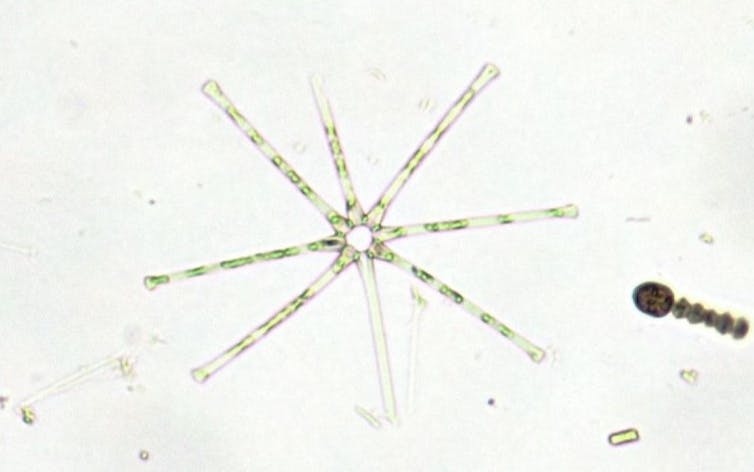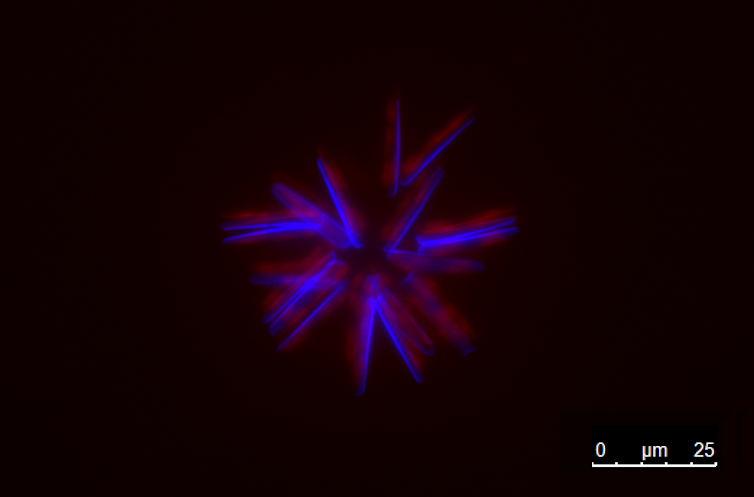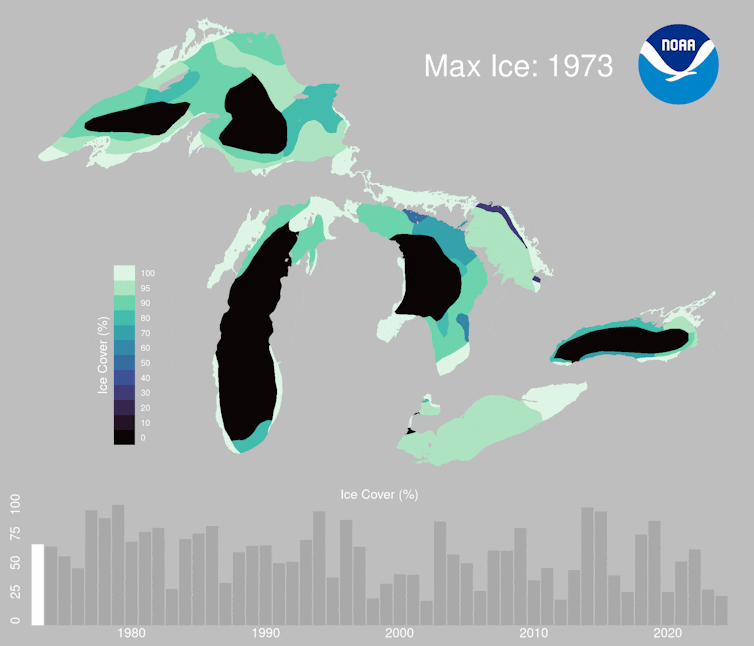Winters on the Great Lakes are harsh – so much so that the scientists who work there often focus on the summer months, when tiny microbes at the base of the food chain were thought to be most productive.
However, emerging research is changing our understanding of these winter ecosystems and shining a light on a vibrant world of winter activity just below the ice.
Scientists discovered in the early 2000s that communities of diatoms – tiny photosynthesizing algae – were thriving in the light under the wind-swept lake ice. But, it turns out, that was only part of the story.
As the Great Lakes’ winter ice disappears – it hit record lows in the winter of 2023-24 – new analyses show that some diatoms appear to have a different way to create energy and survive in the dark, turbid ice-free water until summer.

These microbes are crucial to the Great Lakes’ health. They clean the water of pollutants and are the first step in the complex food web that supports a fishery that powers part of a regional economy. Changes here can have widespread effects on the lakes’ ecology and direct economic effects on surrounding communities.
Oozing up from the ice
Interest in life under the ice erupted in 2007, when an international team of scientists onboard a Canadian Coast Guard icebreaker noticed something unusual as the ship worked its way through the Lake Erie ice.
As the ice broke, dark brown water oozed up from the lake. It was teeming with diatoms.
There had been sporadic studies of the winter microbes in the past, but limnologists – scientists who study lakes – didn’t have the tools to fully understand the microbes’ behavior until recently.

For the past five years, the Joint Genome Institute of the U.S. Department of Energy has supported a molecular biology project that sequenced the RNA of all the microorganisms from samples collected from Lake Erie to address how these organisms survived winter months and might adapt, or not, to future climate scenarios. New observations about how diatoms may be using light are now emerging from this effort.
Using proteins common in animals’ eyes
Normally we think of diatoms as organisms that use sunlight to convert carbon dioxide into living material by photosynthesis. They’re pervasive in summer across the Great Lakes, where they help feed the lakes’ multibillion-dollar sport and commercial fisheries.
During winter, diatoms can create energy from the light that filters through the wind-swept ice. However, when the ice is not present in winter, the diatoms are mixed into lake water that can, at times, be best described as chocolate milk. Light penetrates poorly through this murky water, and the diatoms get less of the specific wavelengths of light that drive photosynthesis.


We collected samples in the winter of 2019-2020 to compare how diatom communities in open waters differed from those that live under ice. We were surprised that when ice wasn’t present, some diatoms were using a different form of energy acquisition – driven by a pigment called rhodopsin.
Rhodopsins are light-responsive proteins that are perhaps best known as a key component of the eyes of animals. In marine systems, it was shown in 2001 that these proteins are involved in generating energy in bacterial cells, specifically producing adenosine triphosphate, or ATP. ATP is a chemical that organisms use as a power supply for many cellular processes, leading to its nickname as the “molecular currency” of living cells.
It now seems that some Lake Erie diatoms use this energy generation mechanism to augment light-limited photosynthesis in ice-free winter months.
Differences in the two processes may be important: Photosynthesis helps cells fix carbon to produce new biomass as well as cellular energy in the form of ATP. With rhodopsins, while ATP is produced, there is no direct carbon fixation.
This means that cells can likely persist but not grow in these murky waters. But in biology, survival is everything: If an organism’s competitors do not survive harsh conditions but the organism does, there will be more nutrients when conditions improve. To this end, the rhodopsins in these diatoms appear to be as much a survival mechanism and an opportunity to persist in murky, ice-free winter conditions.
Watching lake life evolve as the climate changes
As we move into a warmer climate and ice-free era for Lake Erie and other Northern temperate lakes, this data suggests that, over time, the diatoms that thrived in ice-covered lakes may be replaced by diatoms with rhodopsins in winter months.

The consequences of this change are potentially manifold: Small changes at the base of the food web can affect fisheries. Moreover, some diatoms are known to produce compounds that are toxic to wildlife and humans.
We have only guesses at this point as to how changes in algal species will alter fisheries, tourism and coastal resource management in the long run. How algal communities change over time is a response to many drivers, and light is just one. But having the chance to watch this change from the beginning creates a unique opportunity to understand the effect of a warming climate on the Great Lakes and similar lakes around the world.

